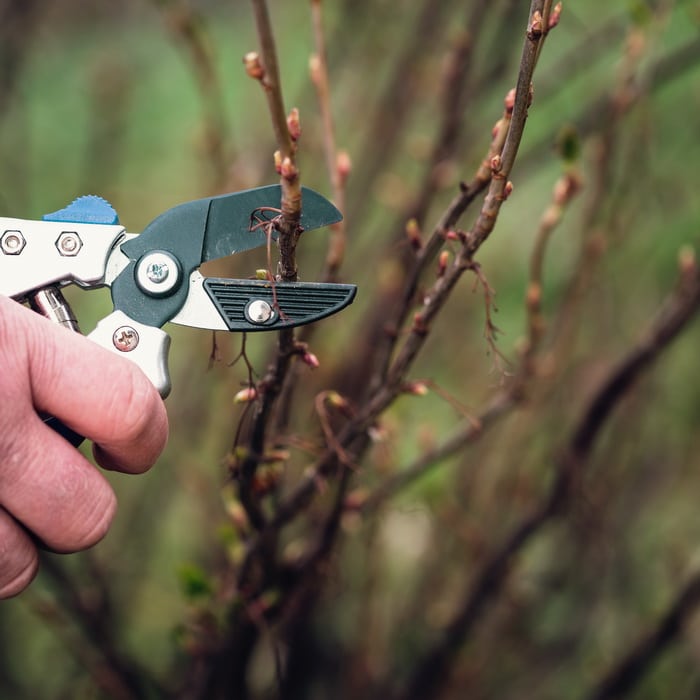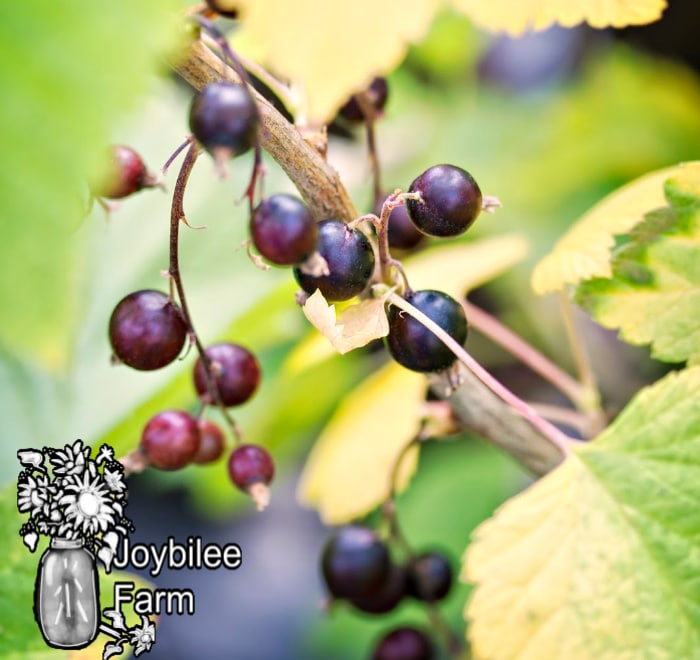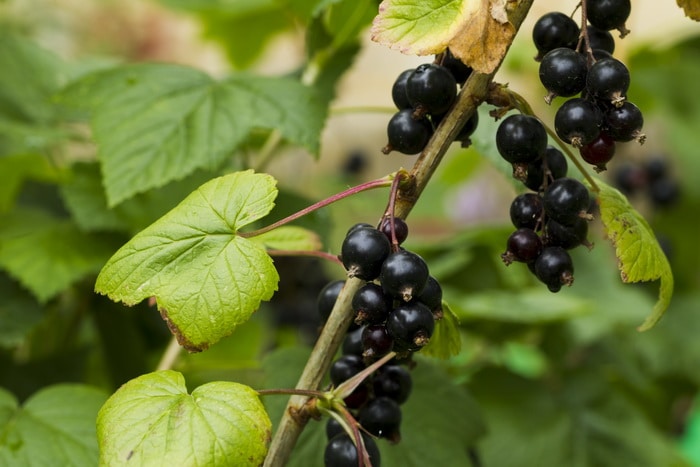Black currants are a hardy berry bush that can tolerate a wide range of conditions in your home garden. The berries are a super food with more anti-oxidants than blue berries. They have a multitude of uses in the kitchen. Learn how to grow black currants and add these tasty, high black fruit to your yard or garden.
Black currants (Ribus nigrum) are a tough and decorative landscape shrub, that is hardy to zone 3. In good loamy soil they will grow to 4 to 5 feet high with a spread of 3 feet.
While the currants like cool, moist soil in full sun, they can tolerate a variety of soil conditions provided they have ample water and good drainage. Currants grow best in summer humid, cool regions with great winter chilling. The bushes stop growing and leaves tend to scorch when daytime temperatures reach 87 degrees F. Each mature bush will provide 8 to 10 pounds of black currants in ideal conditions.
The plants prefer full sun but will also grow in partial shade. Morning sun with afternoon shade offers the best conditions if you can provide at least 6 hours of sunlight under these conditions. Plant them on 5 foot centers to allow for good airflow and to allow easy fruit harvest.
Can you legally grow black currants where you live?
For many years black currants were outlawed in some US states. Many European varieties are susceptible to cedar rust and white pine blister rust. The former affects hawthorn, juniper, saskatoon, and rose. The latter affects white pine plantations and is of commercial importance. Planting resistant varieties like the Canadian cultivar, “Consort” is your best choice in areas where rust is a problem. Fourteen US states currently ban currants in home gardens, with North Carolina having the most restricted rules. Where the airflow is restricted, currant bushes can suffer from mildew as well.
Black currant berries are useful in jams, jellies, tarts, dried for teas, and infused for syrups and more. The rich tone of black currants is indicative of their high anti-oxidant content. In fact, black currants have four times more vitamin C than oranges and twice the antioxidants of blueberries, making them an important fruit for northern growers.

How to plant:
Plant black currant in fertile soil rich in organic matter. When planting in containers, make sure that the roots are loosened, and that the new soil level matches the soil level of the previous pot. Potted black currants can be planted out at any time during the growing season.
Prune potted black currants lightly, if they are actively growing, but do not do a heavy pruning as this could slow their root growth and delay establishment.
If you are working with bare root black currants, you want to plant them during the dormant season. They should be lightly watered in, and pruned down to encourage root growth during dormancy. In the spring when they come out of dormancy, the new growth will start at the roots. Pruning bare root growth, while dormant, helps with establishing the roots and preventing winter-kill of the above ground shoots. After planting prune out all but 3 stems to encourage vibrant growth.
Depending on your area, you may want to heavily mulch black currants with straw or hay to keep the soil moist around the roots. Black currants do best with drip and direct irrigation, as over-head irrigation can contribute to mildew. If you do not have the ability to do direct, or drip, irrigation you can use normal sprinklers, you will just want to monitor the interior of the bushes for mildew, and may want to prune the center for airflow.

Pruning black currant bushes
Black currants fruit on one year old wood, so when pruning leave the past year’s growth and prune out older branches that are no longer bearing. Prune out any wood that is 3 years old or older. Leave at least 3 strong 2 year old stems and 3 stems of the previous years growth. Prune in this way annually until the bushes reach 4 years old. Then prune out any wood that is 3 years old to keep the bushes in top shape. When managed this way, currant bushes will live up to 20 years.
Feed currant bushes in spring with bone meal or an organic fertilizer rated for fruit trees or roses. Lightly cultivate around the shrubs, being careful not to damage the delicate surface roots. Then mulch well with organic hay, alfalfa, leaf mold or straw, to protect the roots from drying out.
Flowers open in May and are pollinated by bumble bees and sweat bees. Fruit ripens the end of July and the beginning of August in Canada. The tart-sweet berries have a distinctive, musky flavor that is appealing in jams, jellies, pies, and juice.
Black currant pests:
Every plant has pests of some type that will attack it. Black currants are no exception, but healthy plants are more resistant to pests than unhealthy or stressed plants. Often you will only need to focus on preventing pests while the plant is getting established, and is weak.
Gooseberry mildew: This is a powdery grey to white mildew that can affect leaves of the black currant shrub. Leaves affected by this mildew should be removed and discarded away from the plants. Make sure the plants have adequate airflow around them to help prevent the mildew. It can also affect the fruit, preventing correct ripening and destroying the crop.
Juniper rust can also affect black currants, as it impacts rose family plants and these shrubs are in the rose family. Make sure to plant black currants away from juniper, Saskatoon bushes, and wild rose to prevent the transfer. This rust mostly affects leaves with some impact on fruit.
Big bud mite: This is a type of mite that attacks the growing tips and young leaves. Affected buds swell, form dried rosettes, and fail to break during following spring. The whole stem becomes blind and dies back to ground. Cut out infected stems, and discard well away from the bushes to prevent spread. This mite can delay current growth for multiple seasons if not caught and addressed. If an infection is too serious, and on-going you may want to replace the affected bushes with healthy stock at the end of the growing season.
Black currant gall midge: This midge lays eggs on the plants and the larvae feed on the young shoots and leaves of the black currant bushes. The larvae are visible to the eye, and affected plant parts should be hand-picked and discarded well away from your bushes.

Propagating black currants
Black currants can be grown from seed. Currant seeds need stratification for 3 to 4 months before germination. Plant currant seeds in damp peat soil and chill outdoors or in the fridge over winter. Plant out in pots the following spring. Plants grown from seed will fruit in the third year after planting. Seedlings will grow much like the parent plants.
Black currants can also be propagated through cuttings in much the same way as roses. Take 10 inch semi–hardwood cuttings. Dip the cut end of the cuttings in cinnamon, as a rooting hormone, and push into fertile soil in a pot. Place the pot in the shade to protect the tender cutting. Cover the seedling with a glass jar or plastic bag to prevent it from drying out. Vent the jar to prevent heat build up. Keep the soil evenly moist. Cuttings should root in 6 to 8 weeks. Plant rooted cuttings out the following spring where you want them to grow. Cuttings will fruit the second year after planting.

Harvesting black currants:
Now the fun part of learning how to grow black currants, or anything for that matter, is learning when to harvest. Black currants are ripe when they are solidly and evenly black. Some cultivars have clusters that ripen all at once, many European varieties have clusters that ripen from the top down. Some black currants have individual berries, with no clusters.
My favorite variety, “Consort” has clusters of black berries that ripen all at once. The plants are self fertile but fruit better when at least two black currant bushes are available for pollinators. They can both be the same variety.
Harvesting technique will depend on your black currant cultivar. Harvest the berries when solidly black and slightly soft to the touch. Black currants have a distinctive tart, musky flavor and are not overly sweet. They are best frozen, used in wine, baking, or jams, or dried for use in teas, or juice. Dried black currants are used in herbal tinctures and herbal syrups in much the same way as black elderberry or bilberries for their rich antioxidant benefits that support the immune system and eye health.
Rinse black currants under cold water before preserving to remove dust and debris then proceed with your recipe.
Check this link for inspiration for 42 ways to use black currant fruit.
Black currants
Black currants are one of many small fruits that can increase the health and vitality of your garden, attracting pollinators, feeding wild birds, and offering abundant, nutrient-rich food for your garden. The bushes are not deer resistant so fencing or other protection should be provided in areas where deer and rabbit damage is prevalent.



Leave a Reply